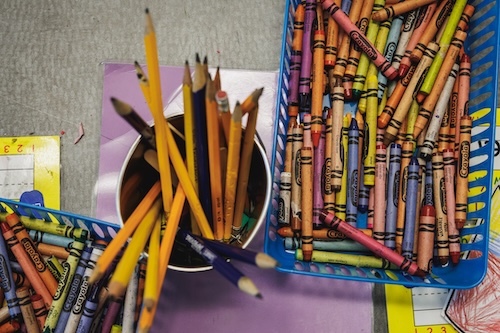
As schools around the country administer spring assessments, a new survey gives us insight into how teachers feel about the tests—especially amid more than two years of disrupted learning.
Teachers generally see assessments as crucial to understanding the full impact of the pandemic, analyzing opportunity gaps between groups of students, and making resource-allocation decisions, according to the survey conducted by Educators for Excellence (E4E) and sponsored by NWEA.
E4E, led by Evan Stone, my coauthor on this post, is made up of 30,000 educators from around the country working to improve student learning, elevate teaching, and create a more equitable education system. In reporting the survey findings, E4E shared an overall sample of national teacher responses as well as the responses of teachers who are Black, Indigenous, and people of color (BIPOC). The survey includes an oversample of BIPOC teachers to better understand their priorities when it comes to policy issues.
Views on assessment
BIPOC teachers see state assessments in a particularly favorable light compared to teachers generally. According to the survey, about half of all teachers strongly believe state summative tests accurately measure student mastery of state content standards, while three-fourths of BIPOC teachers feel that way. In addition, 60 percent of all teachers say they get results in time for them to be useful for informing their instructional practice, while more than 80 percent of BIPOC teachers say that’s the case.
BIPOC teachers are less likely than other teachers to say that the assessments get in the way of or disrupt teaching and learning.
[T]he most useful change [to state assessment] would be to report results in an asset-based way that highlights student strengths as well as areas for growth.
While there is widespread support for state testing among teachers, they’d like to see improvements. Overall, teachers say the best way to make state assessment more useful would be to limit the reporting of results to tested material that teachers already taught. Sometimes, spring testing comes around before teachers have completed their lessons for the year. For BIPOC teachers, the most useful change would be to report results in an asset-based way that highlights student strengths as well as areas for growth.
Retaining our teachers
While there is a lot of concern that broad labor trends in which Americans are quitting their jobs will impact the teaching profession, the E4E survey contains some good news. It shows 86 percent of teachers expect to stay in teaching for their entire career. Of concern, though: only about half of BIPOC teachers say they plan to stick with the profession. While more than half of US public school students identify as people of color, almost 80 percent of teachers are white. Research shows students of color who have teachers who look like them are more likely to succeed academically and that all students benefit from having teachers of color.
So, what might support teacher retention, particularly the retention of BIPOC teachers? While teachers generally say higher salaries can help, BIPOC teachers are more likely to prioritize greater leadership opportunities and more professional development and support.
COVID recovery
Teachers overwhelmingly agree the mental health of their students is worse than before the pandemic and say that hiring more counselors and mental health providers is critical. They also report that schools aren’t meeting the needs of subgroups of students. About two-thirds say that’s the case for English learners, and half of teachers say schools aren’t meeting the needs of students with disabilities and students of color.
“We all see the significant gap that the last two years has created for our students, but so far we aren’t doing the things to meaningfully make up for the lost time and to address our students social-emotional needs,” said Joseph Tadros, a high school math and science teacher in the Bronx.
NWEA research confirms that student achievement in math and reading lags behind pre-pandemic levels, with historically marginalized groups most negatively impacted. The federal government has provided nearly $200 billion to schools to spend over three years to address challenges associated with the pandemic. Unfortunately, most of the teachers in the new survey say they haven’t been consulted about local spending decisions, and only about a quarter think the money is having a positive impact on students’ academic progress.
Let’s talk curriculum
Disturbingly, the new survey finds most teachers don’t believe that their curriculum resources are well-aligned to learning standards or culturally relevant. Just one in three teachers say they have been involved in curriculum decision-making, and most have to spend valuable time creating or downloading materials outside of what their district or school has provided them.
[M]ost teachers don’t believe that their curriculum resources are well-aligned to learning standards or culturally relevant.
“Teachers don’t have the latitude or time to adjust curriculum to their students. So, we are either left to search for new resources or to use tools we know aren’t as effective as they could be. This could all be avoided by including teachers from the start of selecting curriculum,” said fourth-grade teacher Mark Morrison, from Trumbull, Connecticut.
The survey shows many teachers, especially BIPOC teachers, welcome input from parents and other caregivers. About half of teachers think parents should play a role in curricular decisions, with nearly two-thirds of BIPOC teachers believing that.
As the country grapples with how to talk about and teach the history of race and racism in America, teachers stand firmly on the side of open dialogue in schools. When it comes to these conversations, particularly related to historical and current racial injustice, teachers overwhelmingly agree school is an important place to have these conversations and say race, racism, and the history of underrepresented populations should be taught in the classroom. Their views correspond with research showing teaching the history of race in America improves student outcomes.
An opportunity for change
As a whole, the survey provides us with vital information on urgent issues impacting education policy and practice. We hope these findings promote robust and honest conversations in school communities and among policymakers nationwide. By listening to educators and reflecting on what they have to say, we can go a long way toward improving our schools and creating the kind of educational system that allows teachers to excel in their jobs and allows students to thrive in and out of the classroom.
Evan Stone is the co-founder and co-CEO of Educators for Excellence. He helped start the organization in 2010 after working as a sixth-grade teacher in the Bronx.







